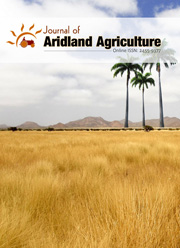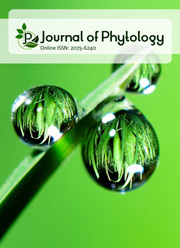Measured versus calculated net radiation and soil surface heat flux values in an automated weather station in arid lands, and its application in the FAO Penman-Monteith method
DOI:
https://doi.org/10.25081/jaa.2025.v11.9291Keywords:
Crop evapotranspiration, FAO-56 method, Soil surface heat flux, Net radiation, Reference evapotranspirationAbstract
For efficient irrigation timing in arid land agriculture, it is essential to know the daily evapotranspiration rate of each crop (ETc) established in a specific location. ETc can be obtained from the reference evapotranspiration rate (ETr) according to the procedure of the FAO-56 method and the crop coefficient development (Kc). However, the daily rates of ETr obtained with calculated values of net radiation (Rn) and soil surface heat flux (G) may differ from those obtained when Rn and G are measured in the same automated weather station. The objective of this study was to evaluate the difference between the daily rate of ETr obtained with the FAO-56 method using calculated and measured data of net radiation and soil surface heat flux in an arid land. On an arid land of northern Mexico, a Campbell-brand automated weather station (Campell Sci., Inc. Logan, Utah, USA) was located at the center of a circular area of 12 m in diameter, with a green grass of full surface coverage 12 cm height with no soil moisture deficit, to measure at a height of 2 m (1 s scan and 30 min averaged values) the air temperature and relative humidity, wind speed and direction, incident solar radiation, barometric pressure, and rainfall. Furthermore, the net radiation over the grass and the soil surface heat flux were also measured. The data generated by the automated weather station was used to calculate the daily rate of ETr (FAO-56 method) using both calculated and measured values of net radiation and soil surface heat flux. The results of this study showed that the ETr (FAO-56 method) obtained with Rn and G measured was 17.63% higher than the ETr (FAO-56 method) determined with Rn and G calculated. The Rn measured (using a net radiometer) was 14.08% larger than the Rn calculated (FAO-56 method). G measured was 36.6% smaller than G calculated as 10% of the Rn (FAO-56 method). The daily ETr rate (FAO-56 method) using Rn and G measured in the automated weather station was higher than the ETr rate (FAO-56 method) obtained with Rn and G calculated, due to a bigger value of Rn and a lower value of G measured in the automated weather station than the values of Rn and G calculated by the FAO-56 method.
Downloads
References
Allen, R. G., Pereira, L. S., Raes, D., & Smith, M. (1998). Crop evapotranspiration: Guidelines for computing crop water requirements (FAO Irrigation and Drainage Paper No. 56). Food and Agriculture Organization of the United Nations. Rome, Italy.
Carmona, F., Rivas, R., & Kruse, E. (2017). Estimating daily net radiation in the FAO Penman-Monteith method. Theoretical and Applied Climatology, 129, 89-95. https://doi.org/10.1007/s00704-016-1761-6
Chen, F., & Robinson, P. J. (2009). Estimating reference crop evapotranspiration with ETgages. Journal of Irrigation and Drainage Engineering, 135(3), 335-342. https://doi.org/10.1061/(ASCE)IR.1943-4774.0000005
Cunha, R. D. A., Clovis, V. A., Joao, E., & Francisco. (2008). Estimating reference evapotranspiration by Penman-Monteith method (FAO-56) with measured net radiation for different sensors. Agronomia Tropical, 58(1), 81-84.
da Cunha, A. R., Schöffel, E. R., & Volpe, C. A. (2014). Estimation of evapotranspiration by various net radiation estimation formulae for non-irrigated grass in Brazil. Journal of Water Resource and Protection, 6(15), 1425-1436. https://doi.org/10.4236/jwarp.2014.615131
Diop, L., Bodian, A., & Diallo, D. (2015). Use of atmometers to estimate reference evapotranspiration in Arkansas. African Journal of Agricultural Research, 10(48), 4376-4383. https://doi.org/10.5897/AJAR2015.10332
Evett, S. R., Schwartz, R. C., Howell, T. A., Baumhardt, L. R., & Copeland, K. S. (2012). Weighing lysimeter ET represent surrounding field ET well enough to test flux station measurements of daily and sub-daily ET? Advances in Water Resources, 50, 79-90. https://doi.org/10.1016/j.advwatres.2012.07.023
García, E. (2004). Modifications to the climatic classification system of Köppen. (5th ed.). National Autonomous University of Mexico.
Gavilán, P., & Castillo-Llanque, F. (2009). Estimating reference evapotranspiration with atmometers in a semiarid environment. Agricultural Water Management, 96(3), 465-472. https://doi.org/10.1016/j.agwat.2008.09.011
Gavilan, P., Berengena, J., & Allen, R. G. (2007). Measuring versus estimating net radiation and soil heat flux: Impact on Penman–Monteith reference ET estimates in semiarid regions. Agricultural Water Management, 89, 275-286. https://doi.org/10.1016/j.agwat.2007.01.014
Intrigliolo, D. S., Lakso, A. N., & Piccioni, R. M. (2009). Grapevine cv. “Riesling” water use in the northeastern United States. Irrigation Sciences, 27(3), 253-262. https://doi.org/10.1007/s00271-008-0140-1
Irmak, S., Howell, T. A., Allen, R. G., Payero, J. O., & Martin, D. L. (2005). Standardized ASCE Penman-Monteith: Impact of sum-of-hourly vs. 24-h time step computations at reference weather station sites. Transactions of the ASAE, 48(3), 1063-1077. https://doi.org/10.13031/2013.18517
Irmak, S., Mutiibwa, D., & Payero, J. O. (2010). Net radiation dynamics: Performance of 20 daily net radiation models as related to model structure and intricacy in two climates. Transactions of the ASABE, 53(4), 1059-1076. https://doi.org/10.13031/2013.32596
Kiraga, S., Peters, R. T., Molaei, B., Evett, S. R., & Marek, G. (2024). Reference Evapotranspiration Estimation Using Genetic Algorithm-Optimized Machine Learning Models and Standardized Penman-Monteith Equation in a Highly Advective Environment. Water, 16(1), 1-12. https://doi.org/10.3390/w16010012
Kuzucu, F. C., & Taş, İ. (2024). Comparación de los valores de evapotranspiración calculados con métodos empíricos y mediciones de ETgage. Preprints, 2024040790. https://doi.org/10.20944/preprints202404.0790.v1
Liu, X., Xu, C., Zhong, X., Li, Y., Yuan, X., & Cao, J. (2017). Comparison of 16 models for reference crop evapotranspiration against weighing lysimeter measurement. Agricultural Water Management, 184, 145-155. https://doi.org/10.1016/j.agwat.2017.01.017
Moratiel, R., & Martínez-Cob, A. (2011). Evapotranspiration of a grapevine trained to a gable trellis system under netting and black plastic mulching. Irrigation Science, 30, 167-178. https://doi.org/10.1007/s00271-011-0275-3
Myeni, L., Moeletsi, M. E., & Clulow, A. D. (2020). Assessment of three models for estimating daily net radiation in southern Africa. Agricultural Water Management, 229, 105951. https://doi.org/10.1016/j.agwat.2019.105951
Oliveira, L. F. C., Carvalho, D. F., Romão, P. A., & Cortês, F. C. (2001). Comparative study of estimative models for reference evapotranspiration for selected sites in Goiás and Distrito Federal. Pesquisa Agropecuária Tropical, 31, 121-126.
Payero, J. O., Neale, C. M. U., & Wright, J. L. (2005). Estimating soil heat flux for alfalfa and clipped tall fescue grass. Applied Engineering in Agriculture, 21(3), 401-409. https://doi.org/10.13031/2013.18459
Tagliaferre, C., Silva, R. A. J., Rocha, F. A., Santos, L. C., & Silva, C. S. (2010). Comparative study of different methodologies for determining reference evapotranspiration in Eunápolis-BA. Revista Caatinga, 23, 103-111.
Tolk, J. A., Evett, S. R., & Howell, T. A. (2006). Advection influences on evapotranspiration of alfalfa in a semiarid climate. Agronomy Journal, 98(6), 1646-1654. https://doi.org/10.2134/agronj2006.0031
Trezza, R., Pacheco, Y., Suárez, Y., Núñez, A., & Umbría, I. (2008). Irrigation programming in sugar cane in a semi-arid area of Lara state, Venezuela, using the FAO-56 methodology. Bioagro, 20(1), 21-27.
Turco, J. E. P., Faria, M. T., & Fernandes, E. J. (2005). Influence of net radiation obtention method compared to the reference evapotranspiration estimate methods. Irriga, 10, 215-228.
Zermeño-González, A., Escalante-Pérez, A., Gil-Marín, J. A., Ramírez-Rodríguez, H., Cadena-Zapata, M., Melendres-Alvarez, A. I., & Méndez-González, J. (2023). Determination of the water use efficiency of a pecan nut orchard based on the irrigation scheduling and the evapotranspiration rate in northern Mexico. The Open Biotechnology Journal, 17, 1-9. https://doi.org/10.2174/18740707-v17-230810-2023-11
Zermeño-González, A., Melendes-Alvarez, A. I., Fuerte-Mosqueda, L. A., Munguia-López, J. P., & Ibarra-Jiménez, L. (2017). Evapotranspiration rate of a vineyard and its relation to the reference of the FAO Penman-Monteith method. Agrociencia, 51(1), 1-12.
Zia, H., Rehman, A., Harris, N. R., Fatima, S., & Khurram, M. (2021). An experimental comparison of IoT-based and traditional irrigation scheduling on a flood-irrigated subtropical lemon farm. Sensors, 21(12), 4175. https://doi.org/10.3390/s21124175
Published
How to Cite
Issue
Section
Copyright (c) 2025 Alejandro Zermeno, Paascual Ervidan Pérez-Díaz, José Alexander Gi-Marín, Homero Ramírez-Rodríguez, Martín Cadena-Zapata, Audberto Reyes-Rosas, Sasirot Khamkure, Aaron Isain Melendres-Alvarez, Luis Samaniego-Moreno

This work is licensed under a Creative Commons Attribution-NonCommercial 3.0 Unported License.





 .
.